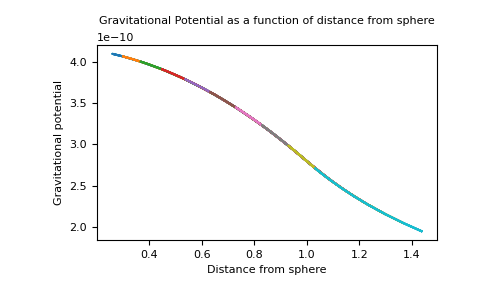geoana.gravity.Sphere.gravitational_potential#
- Sphere.gravitational_potential(xyz)#
Gravitational potential due to a sphere.
\[ \begin{align}\begin{aligned}r > R\\\phi (\mathbf{r}) = \gamma \frac{m}{r}\\r < R\\\phi (\mathbf{r}) = \gamma \frac{2}{3} \pi \rho (3R^2 - r^2)\end{aligned}\end{align} \]- Parameters:
- xyz(…, 3) numpy.ndarray
Locations to evaluate at in units m.
- Returns:
- (…, ) numpy.ndarray
Gravitational potential at sphere location xyz in units \(\frac{m^2}{s^2}\).
Examples
Here, we define a sphere with mass m and plot the gravitational potential as a function of distance.
>>> import numpy as np >>> import matplotlib.pyplot as plt >>> from geoana.gravity import Sphere >>> from geoana.utils import ndgrid
Define the sphere.
>>> location = np.r_[0., 0., 0.] >>> rho = 1.0 >>> radius = 1.0 >>> simulation = Sphere( >>> location=location, rho=rho, radius=radius >>> )
Now we create a set of gridded locations, take the distances and compute the gravitational potential.
>>> X, Y = np.meshgrid(np.linspace(-1, 1, 20), np.linspace(-1, 1, 20)) >>> Z = np.zeros_like(X) + 0.25 >>> xyz = np.stack((X, Y, Z), axis=-1) >>> r = np.linalg.norm(xyz, axis=-1) >>> u = simulation.gravitational_potential(xyz)
Finally, we plot the gravitational potential as a function of distance.
>>> plt.plot(r, u) >>> plt.xlabel('Distance from sphere') >>> plt.ylabel('Gravitational potential') >>> plt.title('Gravitational Potential as a function of distance from sphere') >>> plt.show()
(
Source code,png,pdf)